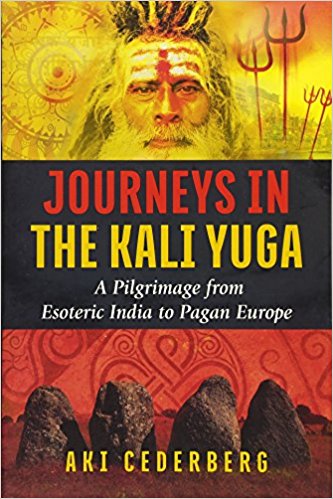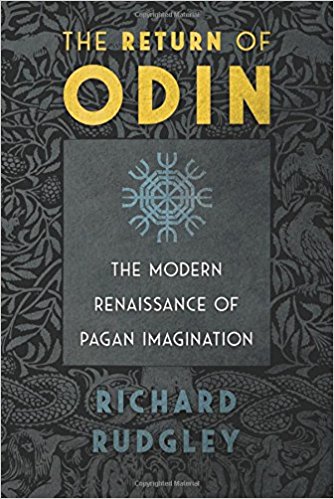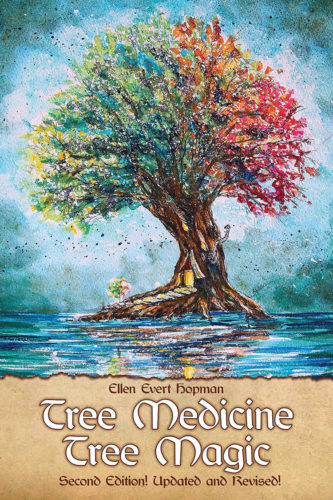Paganism is not a “religion of the book,” but it is a religion of many books. Here’s a look at some recent releases of interest to Pagans, Polytheists and Heathens: a Scandinavian’s travels in esoteric India, a young adult novel inspired by Yoruba religion, an examination of Odin’s influence in modern times, and a tree herbal.
Journeys in the Kali Yuga: a Pilgrimage from Esoteric India to Pagan Europe
Aki Cederberg, Destiny Books, December 2017, 172 p.
In the introduction to this spiritual travelogue, Finland native Aki Cederberg writes that “as far back as I can remember, I have been drawn to and felt a strong resonance with certain sights, symbols, and signs, not exactly knowing why. Some of these have been found in the waking world, while others have revealed themselves in visions and dreams . . . . It’s as if my soul or spirit had been imprinted with images, and consequently my life has been a search for these images in the outside world.”
Cedeberg became intrigued, for example, about the similarities between the trident-shaped Algiz rune of his native Nordic culture and the trishul of the Hindu deity Shiva. His curiosity led him to India.

“His odyssey began as a search for spiritual roots, something missing in the spiritually disconnected life of the Western world, where the indigenous traditions were long ago severed by the spread of Christianity,” reads the book description on the website of his publisher, Destiny Books.
Cederberg, in what is his first book in English, writes that he encountered “a literal army of Naga Babas – the naked ones, the wild, wandering mystics, the holy madmen of Shiva.” He also recounts his adventures with hucksters in Rishikesh, pipe-puffing mystics at a temple of the goddess Maya, the American-born techno-trance deejay Goa Gil, the American-born sadhu Rampuri, and a “raised-arm Baba” who has held up one arm for 40 years to show his devotion to Shiva.
“My initial reaction to all this, of course, as I told Rampuri, was a strong ‘What the fuck am I doing here?’” Cederberg writes. “It was all quite overwhelming and disorienting, suddenly bursting into this alien foreign fairy-tale world.”
Rampuri responds with a Stars Wars tale.
“Oh, great, I thought. A Star Wars analogy,” Cederberg writes, but he was undeterred from his quest: “I wanted not only to see the sadhus, magicians, and shamans, but I wanted to be able to see as they saw.”
Near the end of his odyssey, Cederberg, who lives in Helsinki, reflects on lessons learned: “It had become apparent that for most of the Western individuals I knew their initiation into the Indian esoteric world had not been entirely successful . . . . there is seldom a good reason for a European person to worship Hindu deities, which are . . . specific to them and their lands. For instance, there is something strange in revering Saraswati in Europe, for Europe has its own river goddesses . . . . The more I traveled in faraway lands, the more I felt connected to my own inherited spiritual landscapes.
“All this is not to say that a great deal cannot be learned and experienced from different traditional cultures or that the divine cannot be approached through them, because it certainly can . . . . Yet in the soil one naturally springs from there is an immediacy and an intimacy that would be foolish to overlook.”
Check out Cederberg’s website here.
Children of Blood and Bone
Tomi Adeyemi, Henry Holt and Co., March 2018, 544 p.
Some readers are heralding Nigerian-American, California-based author Tomi Adeyemi as the next J.K. Rowling due to her debut young-adult novel, Children of Blood and Bone.
While Harry Potter’s adventures take place in a fictional British school for magic, Adeyemi drew inspiration from West African mythology and the religion of the Yoruba people in crafting her tale of Zelie, who fights to restore magic to the imaginary country of Orïsha.

The book page on Adeyemi’s website reads in part: “They killed my mother. They took our magic. They tried to bury us. Now we rise.
“Zélie Adebola remembers when the soil of Orïsha hummed with magic. . . . but everything changed the night magic disappeared. . . .
“Now Zélie has one chance to bring back magic and strike against the monarchy. . . .Yet the greatest danger may be Zélie herself as she struggles to control her powers — and her growing feelings for an enemy.”
Children of Blood and Bone shot to number one on the New York Times bestseller list for young adults, the movie rights have been optioned, and a second book in the series is due March, 2019.
Students may also find themselves immersed in Orïsha and communing with Yoruba gods and goddesses in their classrooms. A study guide for teachers on Adeyemi’s website is “intended to support classroom instruction” using her novel and provides suggested activities for students in grades eight through12, including this one: “Have students choose one of the deities in the Maji Clans list to research, drawing from the novel, other print sources, and digital sources. The students should then research a similar deity in another mythology or religion, such as another fire deity. They should write a paper about the Yoruba deity that includes comparisons to the deity from the other culture.”
Ogun must be smiling.
The Return of Odin: the Modern Renaissance of Pagan Imagination
Richard Rudgley, Inner Traditions, March 2018, 304 p. (third edition, revised and expanded)
“A controversial examination of the influence and presence of the Norse god Odin in contemporary history and culture” – so reads the website of publisher Inner Traditions. “Rudgley argues that it is Odin and not Jesus Christ who is the single most important spiritual influence in modern Western civilization.”
In a preface to this new edition, Rudgley writes: “In the years since the first edition of this book was published (in 2006), the renewed cultural and psychological importance of the Norse god Odin has continued to grow in the Euro-American world. Carl Jung characterized this multifaceted deity, whom he calls by his German name Wotan, as the herald of the winds of change that manifested in myriad forms.”

Prehistoric Scandinavian rock art, the Helgo Buddha (an ancient relic excavated in Sweden), the Greek myth of Hyperborea, “yoga” in prehistoric and pagan Europe, hollow earth theories, Blavatsky, Nietzsche, Nazi Germany, more Jung, Tolkien and the Lord of the Rings, wyrd, runes and more surface here.
A chapter titled “The Possessed” discusses Charles Manson, while a subsection titled “America’s Most Notorious Serial Killers: Odin and Loki?” details the comparisons made by French sociologist Denis Duclos between those Norse gods and infamous American serial killers.
Chapters titled “American Armageddon” and “Armed Insurrection in Aryan America” examine the emergence of neo-Nazis, the novel The Turner Diaries (a “modern Mein Kampf,” Rudgley writes), Aryan Nations, Timothy McVeigh, Christian identity and other examples of extremism and/or mayhem.
“Odin has been identified as the prototype of Father Christmas and the inspiration for Tolkien’s wizard Gandalf, yet his sinister presence is implicated in the rise of Nazism and Adolf Hitler as well as in the depravities of modern American serial killers,” Rudgely writes. “Is the pagan legacy to be found in the demonic ravings of the Fuhrer or in the gentle yet hypnotic attraction of The Lord of the Rings, or do both tell part of the tale?”
Tree Medicine Tree Magic
Ellen Evert Hopman, Pendraig Publishing, October 2017, 262 p. (second edition, updated and revised)
This “tree herbal” is “a re-release of the old classic that was out of print for over a decade,” Hopman told The Wild Hunt. “It’s expanded, has full color plates, and lots of tree recipes for ways to eat and make drinks from trees.”

The book includes botanical, historical, herbal, practical, spiritual, mythological, culinary and folk magic aspects of common trees in North America, Europe, and elsewhere.
Hopman will lead a workshop on “Tree Divination Using the Ancient Celtic Ogham Alphabet” from 10 a.m. to 5 p.m. Saturday July 14 and 10 a.m. to 3 p.m. Sunday July 15 at Dreamland in Worcester, Vermont; the cost is $130. For more information, go online at greenmountaindruidorder.org.
Check out Hopman’s website here.
The Wild Hunt is not responsible for links to external content.
To join a conversation on this post:
Visit our The Wild Hunt subreddit! Point your favorite browser to https://www.reddit.com/r/The_Wild_Hunt_News/, then click “JOIN”. Make sure to click the bell, too, to be notified of new articles posted to our subreddit.